Years ago, I thought all utility trailers were basically the same.
If it had wheels and a ramp, it could haul just about anything, right?
But that’s wrong.
I found that out the hard way when I tried to move a skid steer using a trailer meant for landscaping tools. The frame flexed and the tires swayed. I had to stop halfway through the job and get it towed back.
That experience taught me something valuable that you can’t afford to guess.
If you’re searching for the right type of utility trailer, you’re in the right place. In this guide, you’ll learn about 6 common trailer types, how they’re used, and which ones match the cargo and work you deal with.
So, let’s start!
Quick Comparison
Before we break things down one by one, here’s a quick look at how each trailer stacks up:
| Trailer Type | Best For | Load Capacity | Loading Method | Terrain Fit | Towing Needs |
| Flatbed Trailer | Oversized items, building materials | Up to 48,000 lbs | Forklift, crane, manual | Highways, job sites | Full-size truck |
| Enclosed Trailer | Tools, electronics, boxed goods | 2,000–10,000+ lbs | Rear doors or ramp | Paved roads, gravel | SUV or half-ton truck |
| Dump Trailer | Loose materials, debris, soil, gravel | 3,000–20,000 lbs | Hydraulic dump bed | Paved roads, light off-road | Half-ton or larger truck |
| Car Hauler Trailer | Cars, motorcycles, project vehicles | 6,000–15,000 lbs | Ramps or tilt bed | Paved roads, flat lots | Full-size pickup or SUV |
| Tilt Deck Trailer | Wheeled/tracked equipment, low clearance gear | 7,000–14,000 lbs | Tilt bed, no ramps needed | Flat or compact terrain | ¾-ton truck or larger |
| Landscape Trailer | Mowers, mulch, tools, light machinery | 2,000–7,000+ lbs | Fold-down rear ramp | Paved, gravel, packed dirt | Half-ton truck or SUV |
Got a trailer in mind already?
Great! Now let’s break each one down, step by step.
1. Flatbed Trailers
I remember hauling steel beams for a mid-sized building site. We had no crane on location, no dock either. Just a forklift and a few helping hands. That’s when I first appreciated the flatbed trailer. We loaded from the side, strapped everything down tight, and finished in half the time we expected.
If you’ve ever needed to move something big, heavy, or oddly shaped, you’ve probably wondered what kind of trailer can handle it. That’s where flatbeds come in.
A flatbed trailer is a long, open platform with no sides or roof. You can load cargo from the back, the sides, or even from above. That flexibility solves a common problem: how to move large or awkward items without squeezing them into a box.
These trailers are often used to carry things like steel, lumber, machinery, or large containers. Basically, anything that doesn’t need to be protected from rain or wind.
Features
Let’s take a closer look at what makes flatbed trailers so useful:
- Terrain and road fit: These trailers are best for paved roads, highways, and job sites with level ground. If you’re hauling into a muddy field or rocky path, you’ll need to drive slowly and carefully.
- Load capacity and size range: Most flatbeds range from 48 to 53 feet long and about 8.5 feet wide. They can carry up to 48,000 pounds, depending on the trailer and how it’s built.
- Loading and unloading ease: No walls means you can use forklifts or cranes from any side. I once helped a team unload prefabricated wall panels using a boom truck—it was fast and safe.
- Towing requirements: You’ll need a truck with a strong enough engine and proper hitch system. Always check your truck’s specs before towing a full-sized flatbed.
How It Works
Using a flatbed is pretty straightforward. You load the cargo, place it evenly across the deck, then tie it down using straps, chains, or binders. I’ve found that checking the load every few hours on a long drive is smart—it keeps things from shifting and saves you stress.
Wondering how to keep irregular-shaped items from sliding around? Using wood blocks or rubber mats under the cargo helps add grip and balance.
Best Cargo Types
Flatbeds are perfect for carrying:
- Heavy machinery like excavators or forklifts
- Construction materials like steel, lumber, or rebar
- Vehicles and equipment that need to be driven or rolled on
- Large containers or crates that don’t fit in enclosed trailers
Application
Many industries use flatbeds daily. Here’s where they show up the most:
- Construction: Transporting materials and machines to active job sites
- Agriculture: Moving tractors, hay bales, or irrigation pipes
- Manufacturing: Delivering large machine parts or metal sheets
- Oil and gas: Hauling pipes, tanks, and drilling gear
I once delivered scaffolding for a bridge repair team. Tight schedule, early morning drop. Without a flatbed, there’s no way we would’ve hit that deadline.
Recommended For
Flatbeds are best for:
- Jobs that involve wide or long cargo
- Businesses that load from the side or overhead
- Drivers who want fast, flexible loading without the walls getting in the way
If you’re hauling heavy-duty goods that don’t need to be covered, this trailer might be exactly what you’re looking for.
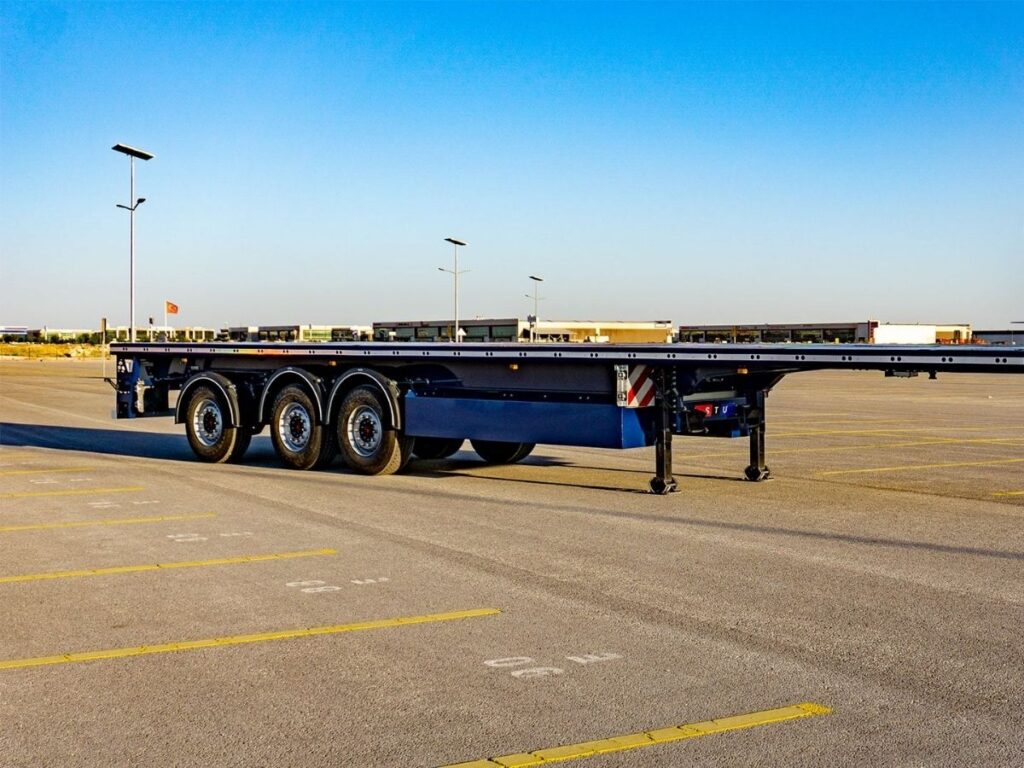
2. Enclosed Trailers
An enclosed utility trailer is like a moving storage room. It has walls, a roof, and usually lockable doors. This design keeps your cargo safe from rain, dirt, road dust, and even theft.
Unlike open trailers, enclosed ones let you stack and organize your load inside a protected space. Some models even come with side doors, ramps, or interior shelving.
What’s the benefit for you? You can haul almost anything without worrying about the weather or about someone walking off with your tools.
Now that you know what it is, let’s talk about how it functions on the road.
Features
Enclosed trailers vary a lot in size, layout, and towing needs. But they all share a few key features worth knowing.
Terrain and Road Fit Most enclosed trailers are made for paved roads or well-kept gravel surfaces. If you’re heading into rough ground or mud, it gets tricky. I once tried backing one into a wet field—it sank fast. I had to call for a tow.
Load Capacity and Size Range These trailers come in a wide range of sizes. You’ll see common models like:
- 5×8 feet: good for small loads
- 6×12 feet: great for mid-sized gear
- 8.5×24 feet: ideal for bigger hauls
Depending on build and axle type, they can handle between 2,000 and over 10,000 pounds.
Loading and Unloading Ease Most have rear swing doors or fold-down ramps. Personally, I prefer the ramp option when moving things on wheels like pressure washers or carts. It just makes the job smoother.
Towing Requirements Because they’re heavier than open trailers, you’ll need a truck or SUV with solid towing capacity. Always check your vehicle’s manual before hitching up. Trust me, I’ve made that mistake before.
Once you understand the specs, it helps to know what using one actually feels like.
How It Works
Using an enclosed trailer is pretty straightforward. You load your items, stack them securely, and use straps or tie-down points to keep things in place. For extra protection, I like to use moving blankets between boxes and walls.
Then you close the doors, lock them up, and hit the road.
I usually stop after the first 30 minutes to check for shifting. It’s a simple habit, but it’s saved me more than once.
Best Cargo Types
Enclosed trailers are ideal for hauling:
- Power tools
- Electronics
- Furniture and boxed items
- Small machinery
- Event equipment like tents and lighting gear
If it can’t get wet, dirty, or stolen easily, this trailer makes sense.
Application
You’ll see enclosed trailers used in several industries. Here are some real-world examples:
- Construction: Keeping tools dry and secure between jobs
- Retail and Distribution: Delivering packaged goods to multiple locations
- Agriculture: Transporting feed, fencing supplies, or small equipment
- Event Services: Moving tents, banners, and audio equipment for gigs
One time, I hauled a full booth setup for a trade show, tables, banners, lighting stands. It rained halfway there, but everything arrived in perfect shape.
Recommended For
This type of trailer is a solid fit if you:
- Need to keep cargo dry or protected
- Haul valuable tools or equipment
- Work across multiple job sites
- Need storage you can lock overnight
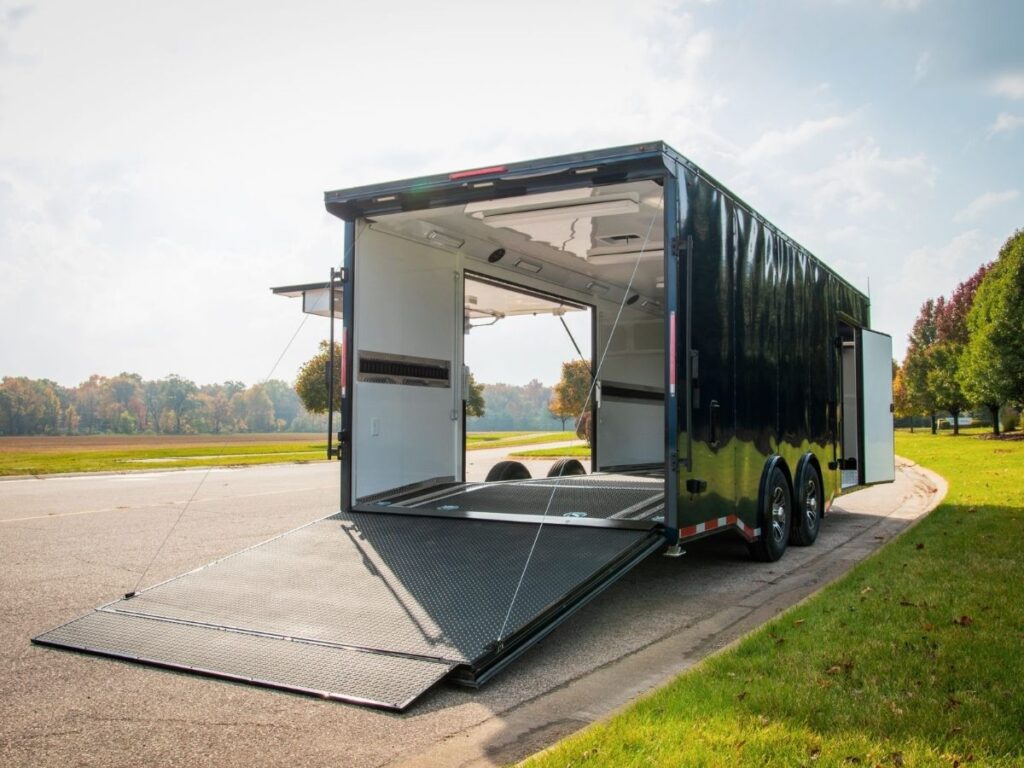
3. Dump Trailers
If you’ve ever moved heavy, loose material like dirt, rocks, or debris, you know how tiring it can be. That’s where dump trailers help.
A dump trailer is a heavy-duty utility trailer with a built-in hydraulic lift. This system tilts the trailer bed, allowing cargo to slide out the back without needing to unload it by hand.
Unlike flatbeds or enclosed trailers, dump trailers are made for bulk material. Think sand, gravel, concrete chunks, or piles of yard waste. They help solve one big problem: cutting down the time and effort it takes to unload.
Now that you know what it does, let’s break down what it’s built for.
Features
Not all dump trailers are the same. They come in different sizes, shapes, and weight limits. Here are the key things to look for:
Terrain and Road Fi
Most dump trailers handle paved roads, gravel, and light off-road conditions. I’ve driven mine across job sites with uneven ground, and as long as the tires are right, they do fine. Just avoid deep mud or steep hills, it’s not worth the risk of tipping.
Load Capacity and Size Range
Dump trailers come in three general sizes:
- Small (around 5×8 feet): Great for yard work and small projects
- Medium (like 6×12 feet): Good for debris, firewood, or light construction
- Large (7×14 feet and up): Ideal for gravel, soil, and bulk materials
Capacity can range from 3,000 to over 20,000 pounds. Choose one based on how heavy your usual loads are.
Loading and Unloading Ease
This is where dump trailers shine. You load them just like any other trailer. But when it’s time to unload? You flip a switch. The bed rises, the back gate opens, and gravity does the rest.
Once, I delivered a load of mulch to a client’s backyard. Instead of spending an hour shoveling, I backed up, raised the bed, and drove away five minutes later.
Towing Requirements
Because dump trailers are heavier than most utility trailers, you’ll need a vehicle with enough towing capacity. A half-ton truck might work for smaller models, but the bigger ones need more muscle. Always check your truck’s towing limit before hitting the road.
Now that you know the specs, let’s look at how it all works in action.
How It Works
Using a dump trailer is simple, but a few steps make all the difference.
- Load your materials evenly to keep the trailer balanced
- Cover your load with a tarp if needed to keep things from blowing out
- Use tie-downs if you’re moving bulky items like stumps or scrap
- At your drop-off site, unlock the rear gate, activate the lift, and let gravity do the unloading
I always stop mid-way through the unload to check the angle. It helps control where the pile lands.
Best Cargo Types
Dump trailers are great for moving:
- Gravel, dirt, sand, or mulch
- Demolition waste or scrap
- Firewood and yard debris
- Grain, feed, or crop waste on farms
If your cargo is loose, heavy, or messy, this trailer makes life easier.
Application
These trailers are common across several industries:
- Construction: Hauling bricks, concrete chunks, or fill dirt
- Landscaping: Moving soil, gravel, and plant material
- Agriculture: Carrying feed, compost, or harvested material
For instance, a landscaping company can use a dump trailer to deliver large quantities of soil to multiple clients efficiently.
We’ve helped dozens of businesses do exactly that by matching them with the right trailer for the job. Rhinotrail offers a full range of customizable semi-trailers, including dump, container, low-bed, tanker, and refrigerated models, all backed by practical design and years of industry know-how.
Recommended For
You’ll get the most out of a dump trailer if:
- You move loose or heavy materials often
- You want to reduce time spent unloading
- You work in construction, landscaping, or farming
- You want something that handles big jobs without big headaches
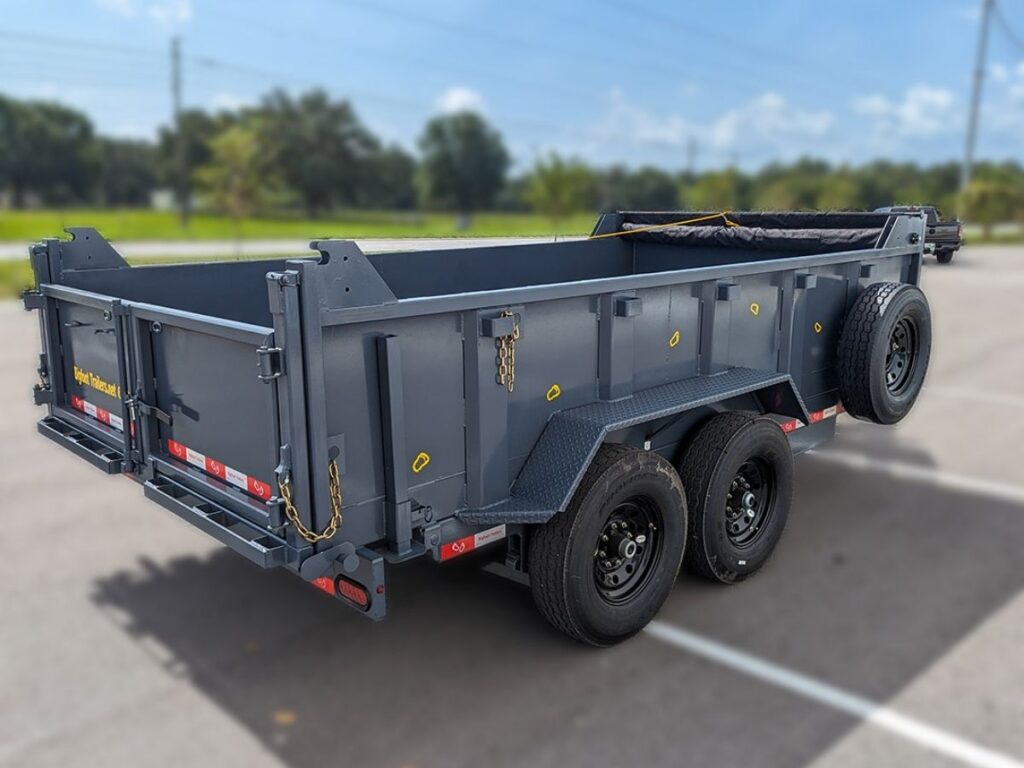
4. Car Hauler Trailers
A few years ago, I bought a used pickup for a rebuild project. The body was solid but the engine was barely hanging on. Driving it home wasn’t an option, so I rented a car hauler trailer and brought it back on my own terms.
If you’ve ever picked up a fixer-upper, you know the peace of mind a car hauler brings.
A car hauler trailer is built to move vehicles safely and easily. It’s basically a flat platform on wheels, usually with ramps or a tilt deck so you can drive or roll a car on and off.
Some are open. Some have fenders. Some are enclosed. But the purpose is the same, to give you a secure way to move a car from point A to point B without adding wear and tear.
They come in different sizes and capacities, but they all aim to make car transport simpler. Whether it’s a classic car, a broken-down vehicle, or something fresh off the lot, this trailer gets it where it needs to go.
Let’s look at the details that help you decide if this trailer fits your needs.
Features
There are a few things that matter most when choosing a car hauler. Size, towing power, and how easy it is to use.
Terrain and Road Fit
Car hauler trailers are made for paved roads and highways. Their ground clearance is low, which helps with loading cars but not great for rough trails or uneven ground. I once tried to cut through a gravel alley to save time. Bad idea. The fenders scraped, and I ended up backing out slowly.
Load Capacity and Size Range
Most car haulers range from:
- 16 to 20 feet: good for single vehicles
- 24 feet or more: fit for two cars or large trucks
Weight limits vary too. You’ll see options that handle between 6,000 to 15,000 pounds. It all depends on how many axles and what kind of frame you’ve got.
Loading and Unloading Ease
Many come with fold-out ramps or a tilt bed. I’ve used both. The tilt bed feels smoother, especially for low-clearance cars. But ramps work fine if you’re patient and have a good spot to load.
Towing Requirements
You’ll need a vehicle with enough power to pull it. Full-size trucks or SUVs usually do the job. Don’t guess—check your vehicle’s towing limit before you hitch up. I’ve seen someone try to tow a car hauler with a crossover. They didn’t make it five miles.
Now that you’ve seen the specs, let’s walk through how it works in real use.
How It Works
Loading a vehicle on a car hauler isn’t hard, but you need to do it right:
- Line up the ramps or tilt bed.
- Drive the car up slowly, or winch it if it’s not running.
- Use ratchet straps or wheel nets to tie down all four tires.
- Lock the trailer coupler and double-check your chains and lights.
- During the trip, stop once or twice to check your tie-downs.
Doing it this way has saved me more than once from a wobbly ride.
Best Cargo Types
These trailers are built for more than just regular cars. You can use them to haul:
- Sedans, SUVs, and trucks
- Classic or collectible vehicles
- Non-running cars for repairs
- ATVs or motorcycles if spaced and strapped right
Basically, if it rolls, it can ride on one of these.
Application
Car haulers are used in all kinds of businesses:
- Dealerships: Moving inventory between locations
- Repair shops: Picking up broken-down vehicles
- Rental fleets: Transporting cars between branches
- Car enthusiasts: Taking show cars to events or races
A mechanic I know uses his hauler every week to pick up cars that can’t start. He says it’s his most-used piece of equipment.
Recommended For
You’ll benefit from a car hauler if:
- You transport vehicles often
- You work in auto sales or repairs
- You own a car that doesn’t always drive
- You want to avoid adding miles to your nicer vehicles
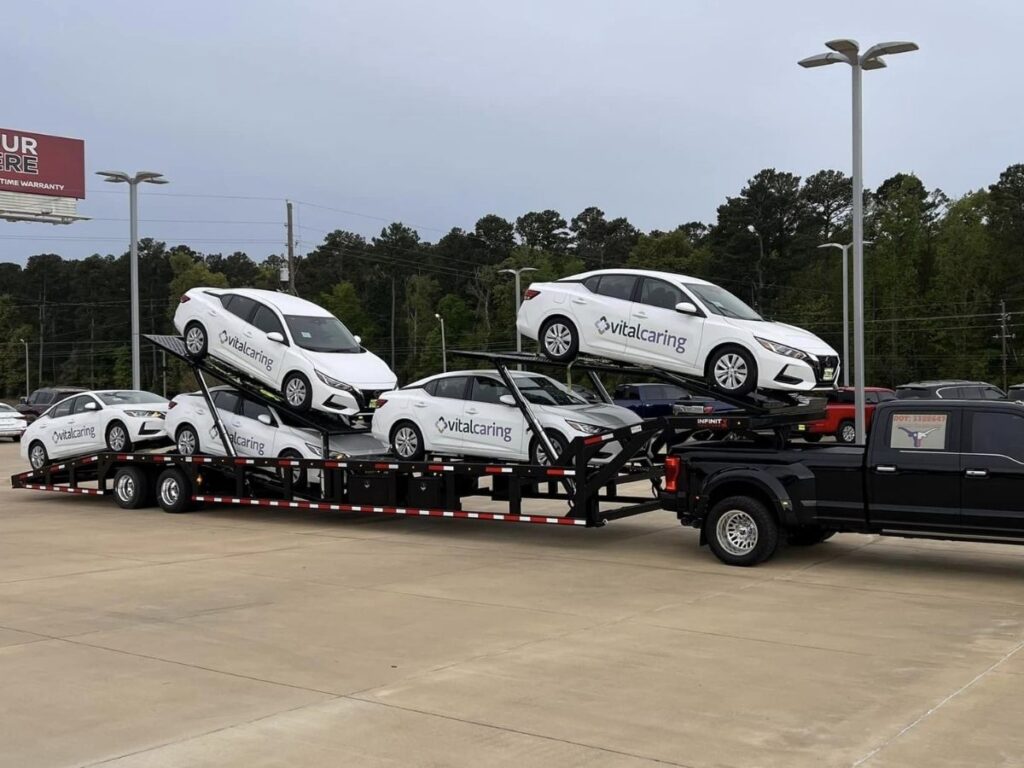
5. Tilt Deck Trailers
If you’ve ever had trouble loading heavy equipment or low-clearance gear, you know how tricky it can get. A tilt deck trailer makes that process easier and a lot safer.
A tilt deck trailer is a utility trailer with a bed that tilts to the ground. You won’t need ramps. Instead, the entire platform leans back, creating a low angle that lets you roll or drive equipment straight on.
There are two main types. Some use hydraulic power, which means a button or lever controls the tilt. Others use gravity tilt, where the weight of the load helps the bed settle back into place.
This type of trailer solves a simple but common problem: how to load wheeled or tracked equipment without awkward ramps or risky setups.
But is it the right choice for you? Let’s look at the key features.
Features
Understanding what makes a tilt deck trailer different can help you decide if it fits your work.
Terrain and Road Fit
Tilt trailers work best on flat, firm surfaces. Pavement, compact gravel, or packed dirt all work well. I’ve used one at a job site with uneven ground, and it handled fine as long as I parked level. On soft or sloped surfaces, though, the tilt can shift too quickly.
Load Capacity and Size Range
Most models fall into these ranges:
- 14 to 22 feet long
- 6.5 to 8.5 feet wide
- Weight capacity: 7,000 to 14,000 pounds
That’s enough for small tractors, scissor lifts, or multiple ATVs. Always check the axle rating and frame strength to match your typical load.
Loading and Unloading Ease
This is where tilt deck trailers stand out. There are no ramps to store, line up, or lose. You just unlock the tilt, load your machine, and let the weight settle the bed back down. I’ve loaded a forklift solo in less than 10 minutes using this setup.
Towing Requirements
These trailers are heavier than basic utility trailers. A half-ton truck might be enough for smaller versions, but heavier models need a ¾-ton or larger. Before you tow, check your vehicle’s capacity. It’s not worth guessing—I’ve seen that go wrong.
Now that you understand how the design helps, let’s break down how it actually works during use.
How It Works
Using a tilt deck trailer is pretty simple once you get the hang of it:
- Park on level ground
- Unlock the tilt mechanism
- Let the bed lower gently
- Load your equipment
- As the weight shifts, the bed tilts back into place
- Lock the bed and strap your load down
I usually double-check the tilt pin and the tie-downs before hitting the road. It gives me peace of mind.
Best Cargo Types
So, what kind of equipment works best on this trailer? You can haul a wide variety of gear:
- Skid steers and mini excavators
- Forklifts and scissor lifts
- ATVs, UTVs, or golf carts
- Palletized materials (if you’re using a forklift)
If it rolls, drives, or can’t handle steep ramps, a tilt deck trailer is probably a good match.
Application
Tilt deck trailers show up in more industries than you might expect:
- Construction: Great for compact machines like trenchers and rollers
- Landscaping: Move sod cutters, mowers, or compact loaders
- Rental services: Deliver light equipment to job sites
- Agriculture: Haul small tractors or utility vehicles between fields
I once saw a landscaping crew load three different machines in under 15 minutes using just one tilt trailer. That would’ve taken twice as long with ramps.
Recommended For
You’ll benefit most from a tilt deck trailer if:
- You haul wheeled or tracked equipment regularly
- You want faster, safer loading without ramps
- You work in construction, landscaping, farming, or equipment rental
- You’ve ever struggled to load low-clearance machinery
If you’ve ever lost time setting up ramps, or worried about gear slipping during loading, this trailer is worth a look. A tilt deck gives you one less thing to fight with, so you can focus on the job, not the struggle.
At Rhinotrail, we believe the right trailer doesn’t just carry cargo, it moves your business forward. From container and dump trailers to custom-built low-beds and tankers, we help companies like yours haul smarter.
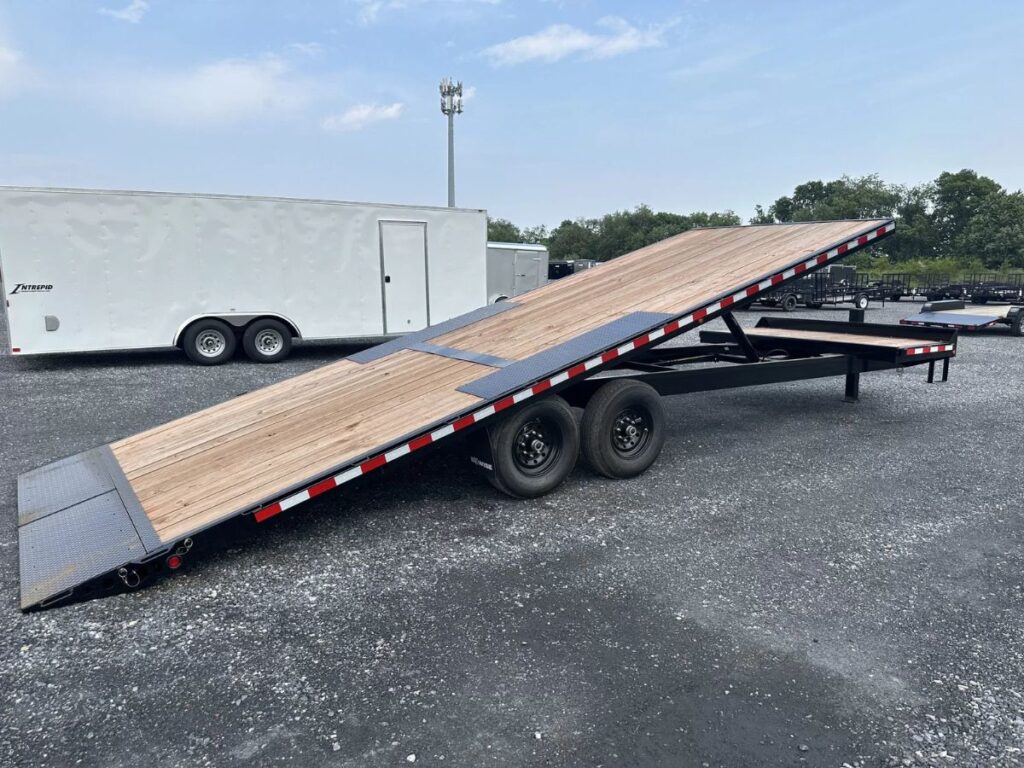
6. Landscape Trailers
Last spring, I offered to help a friend clean up his overgrown yard. We had to haul a riding mower, piles of branches, and a few hundred pounds of mulch. His small truck bed couldn’t handle it all, so we rented a landscape trailer. We loaded everything in one trip and still had space left over.
That trailer saved us time and a lot of back-and-forth driving.
If you’ve ever worked in landscaping or just had a big outdoor project, you know how quickly equipment and materials add up. A landscape trailer makes those jobs much more manageable.
A landscape trailer is a utility trailer designed for moving landscaping tools, machinery, and loose materials. Most have an open flatbed design, with low sides or railings, and come with a wide rear ramp for easy loading.
What sets these trailers apart is how much they can carry in one go. Instead of trying to cram everything into a pickup or making multiple trips, a landscape trailer gives you space, organization, and better hauling power.
You might be wondering: is it built to handle the kind of work you do? Let’s look at the features that matter most.
Features
Terrain and Road Fit
Landscape trailers do well on paved roads, gravel paths, and packed dirt. I’ve pulled mine across driveways, parking lots, and even a bumpy park trail. As long as the path isn’t muddy or deeply rutted, you should be fine.
Load Capacity and Size Range
These trailers come in a few standard sizes:
- 5×8 feet to 6×12 feet: great for smaller tools and mowers
- 7×16 feet to 8×24 feet: better for commercial use or multiple machines
Load capacities can range from 2,000 to over 7,000 pounds, depending on whether it’s a single or tandem axle trailer. Pick the size based on how much gear you need to move at once.
Loading and Unloading Ease
Most models have a fold-down ramp at the back. Some ramps are mesh, which keeps the weight down. Others are solid steel. Either way, loading riding mowers, push carts, or even pallets is quick and easy. No need to lift anything, you can roll or drive it on.
Towing Requirements
You’ll need a truck or SUV with enough towing power. I use a half-ton pickup with no issues on most mid-size models. Just be sure your hitch and trailer brakes are rated for the load. It’s always safer to check before you hit the road.
Now that you know what it looks like and how it’s built, let’s talk about how to use it properly.
How It Works
Here’s a basic breakdown of how you’d use a landscape trailer:
- Hitch the trailer to your towing vehicle. Double-check the coupler, chains, and lights.
- Lower the ramp and load your equipment. Try to keep heavier items centered over the axle.
- Secure everything with straps or tie-downs. Don’t skip this part—even light tools can shift in transit.
- Fold the ramp back up, lock it in place, and you’re ready to go.
I’ve learned to always keep a few extra bungee cords and ratchet straps in the toolbox. They’ve come in handy more times than I can count.
Best Cargo Types
This trailer handles all sorts of landscaping jobs. Here are a few examples:
- Lawn care tools: mowers, trimmers, blowers
- Bulk material: mulch, gravel, bags of soil
- Yard debris: branches, leaves, grass clippings
- Small machines: sod cutters, tillers, mini-tractors
If it fits on the deck and rolls or stacks, it’s a good match.
Application
Landscape trailers are used by more than just lawn care crews. Here’s where they show up most:
- Professional landscapers: moving gear between job sites
- Construction crews: hauling tools and light materials
- Farmers and ranchers: transporting supplies around their land
- DIY homeowners: for big garden projects or seasonal cleanup
Recommended For
A landscape trailer is a good fit if:
- You transport tools and materials often
- You need something that loads quickly and keeps things organized
- You want to cut down on trips and save fuel
- You’re running a landscaping business or doing regular outdoor work
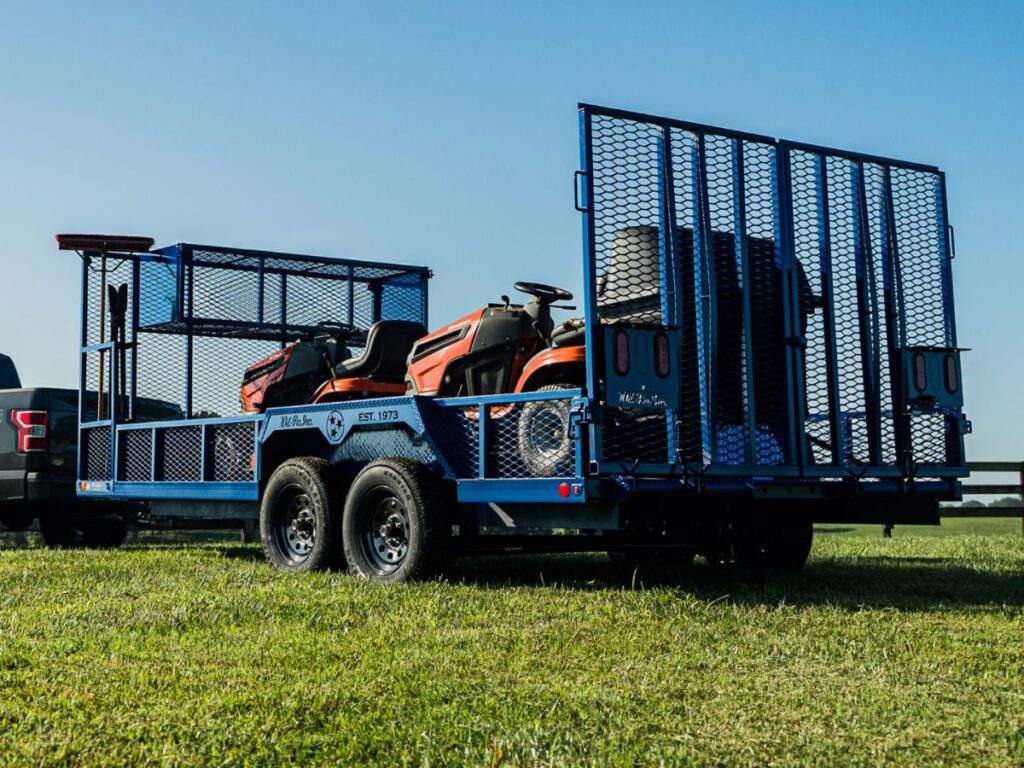
Conclusion
You’ve just gone through 6 types of utility trailers, each built with a specific job in mind. From hauling dirt and gravel to moving tractors, tools, or finished goods, there’s something here that speaks to your work.
I’ve made the mistake of choosing the wrong trailer before. It cost me time, energy, and more than a few headaches but I’ve also seen how the right one can completely change the way a job flows, faster load-ins, fewer delays, and less stress.
Now, which trailer could give you the boost your business needs?
Which one would make the work feel smoother, safer, or just plain easier?
You’ve got the knowledge and a clear view of your options. And maybe, just maybe, you’re closer than ever to making a better choice.
Contact us today! We’re here to help you make the smart move.


